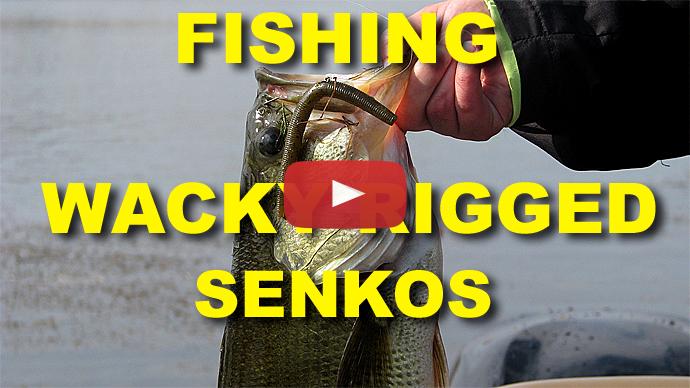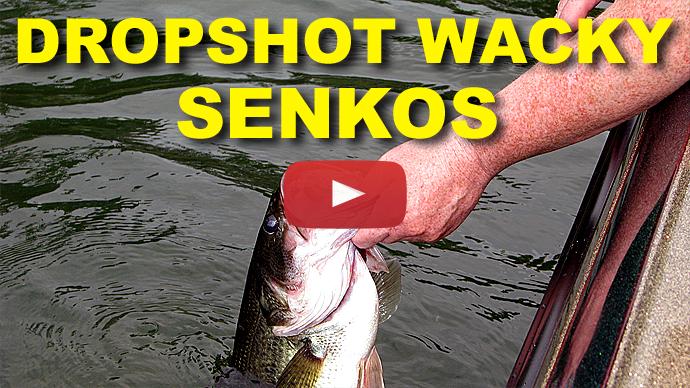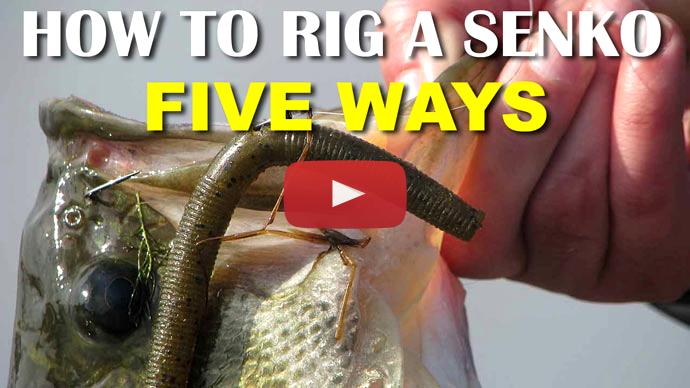Glenn: He's right here, at the point. See him? Go to him. Take it. Let him take it. He doesn't have the hook. There he goes.
Keri: That was awesome. Come here, little guy? Come here.
Glenn: He's not so little. He's not bad.
Keri: No, he's not. He's the biggest one I've caught here. Come say hi to Glenn. Say hi. Hi. Come here. Come on. Come here. Yeah, I had to wait for you to eat it. And then you ate it. Are you wore out? He's a good size.
Glenn: There you go. That works.
Keri: That worked. All right. Thank you, dude. Thank you. Go have fun now.
Glenn: Hey, folks. Glenn May here with BassResource.com. And today I want to talk to you about the best places and times to fish a wacky rig. Now, when I thought about this, it's like, you know, you can probably fish a wacky rig year round. What changes though, is how you fish it and where you fish it, and why you fish in different places. So, that's what I want to talk about today. What we're talking about is this guy right here, the wacky rig. Woohoo.
This is the basic way how I fish it. What I'd like to do is... See this? This is the hook I like to use. See this? It's got a little wire weed guard on it. Okay. Now, the reason I do that is because it adds to the versatility. I can fish it in a lot of different places because of that, and I'm not going to get hung up, or get hooked onto wood, or logs, or anything like that.
So, basically, let's start off with, in the springtime where I fish and when I fish it. Spring is a great time to fish this bait. When the fish just move up and they're just getting shallow. They're really skittish that time of year. Any movement that you do, they're gone. So, this is a great subtle bait to fish during that time of year. You can cast it, it lands softly and has a real subtle approach, real subtle fall. So, it doesn't really spook them.
So, I like to fish this when they first move up shallow, anywhere up to 10 feet deep. The flats usually right up to the edges of flats at the beginning of the spring. And then as the spring progresses, they're gonna move further and further up the flats. Over the weed beds, in the lily pads, I like to fish it by docks, because they'll move up and get up underneath the docks. This is a great bait to skip under docks. Perfect for the springtime.
One of the other ways I like to fish it is when those weeds are first starting to grow, the milfoil, the hydrilla, it starts to come up. I put it on a drop shot, and I'll put it out there where the length of the leader is just enough to put the bait rides above where the weeds are starting to grow. That is a great place. You can position it right there where the fish can see it. There'll be down in the weeds, they'll see it above it. They'll come up and they'll attack it. So, that's a really good way to fish this in the springtime.
Now, as we get into the spawn, this actually works really well put it again on a drop shot. I like to cast it out where the weight is just past the bed and tighten up on the line. You can dance it right over the top of the bed, keeping the weight on just the opposite side of where you're at and just pulling on it. You're going to dance this above the bed, give it some slack, let it flutter back down and so on and so forth, and a lot of times, that just entices the bass to hit. So, great way to fish it during the springtime.
Keri: That time I got him. A little largie. Come back here. Come hither. Right on the nose. I got you right on the nose. I got you through the nose, actually. Sorry, I broke your nostril. Stop it. That's a cutie.
Glenn: Moving into the summer, it changes a bit because before we had all these fish up shallow getting ready to spawn. Well, now they moved and some of them still stay up shallow during the summertime, and you can still fish it the ways I just told you, but you can also move out deeper. A lot of fish move out in the offshore structure, and what I mean by that is they're out by points, they're out in humps, rock piles, brush piles, you'll find them in ditches, creek beds, that sort of stuff.
So, what I like to do then is I like to put a little bit of weight on it. So to get a little bit deeper, I'll use two different jigheads for the most part. One is something like this. Look at how odd that is, that weird shape. But I like to use this one because what it does is it adds to the wobble as it falls, gives a little more action. The summertime, the fish are actively feeding, they look for things that are moving, it's a little more aggressive, and that gets their attention.
So, I use this, it's usually about an 1/8 ounce to 1/4 ounce weight, nothing too heavy, or sometimes I'll go to something like this. See the little weed guard on that little jig head? I'll use that. And that, again, with this weed guard on there, I can throw it down the stump fields, I can throw it down in the deeper vegetation and not get hung up as much. But I like to get that so I can get down deeper. And then sometimes in the summer, what happens, the fish, if they're lethargic, say for example, right after a front comes through, something like that, they're not as willing to bite.
This is where it does really well with the jig head like this, I use a football head jig just like that and that... See how big that is? That's a 1/2 ounce right there. I'll go up to a ¾ ounce. Now, I'm not putting a heavy jig on there because I wanted it to get down deep fast. What I want it to do is when you're fishing down really deep, you know, 20 feet or more on those rock piles, and ledges, and edges in river channels, it's usually rocky down there. I like to get this down there so I can lift the rod up and down and bang it on the rocks and that gets their attention. It gets their curiosity up. They hear it, and they come to check it out, and they see that wacky rig.
I like to use a Yum Dinger here, use this little Yum Dinger. They see it just bouncing up and down on the bottom, and they attack it. So, that's a great way to fish in the summertime. And if the bite is really slow, sometimes these fish are just super lethargic, they're hanging down on the bottom, and they just don't want to bite. That's when I'll rig it on a drop shot, and, again, I'll fish those outside deeper waters where you've got all that structure with a drop shot, and I'll just set it out there, and just hold the rod, and don't even move it and let the breeze just gently move the boat along.
And what's happening is it's just kind of going along the bottom, and it's causing it to quiver a little bit. And then I'll just shake the rod tip just a little bit. I just want that tip to quiver, and give that bait a little bit of action. And that works really well in the summertime when the fish really aren't in a mood to bite. It's a great way to fish it.
But moving on into the fall, now it changes a little bit. In the fall, again, a lot of fish move up shallow. Now, this, especially if you're in the southern part of North America, where you have a lot of shad. The shad move up shallow back in the backs of coves, the backs of bays, and wherever the baitfish are, that's where the bass are. So, the bass will chase them on up there. So, it's again very similar to fishing springtime except I won't go as far back in the big flats, big expensive flats, but I will fish those creek channels, fish the points, the secondary points in the bays. And I'll use the drop shot a lot in those instances to fish a little bit deeper on the weed edges, to get that right through the weeds, and bounce it through there.
You can also fish it again back to this, you know, with this hook again. If it's really weedy, like skipping under docks, there'll be under docks sometimes, so kind of versatile, but fish it a bit shallow. Now, if you're in the northern part of North America, we don't have the shad, we have perch. And a lot of times what happens, especially as you move through the fall season, the perch will group up. They'll school up in a big ball offshore, the bass will hang up underneath them, ready to eat anything that comes through.
So, what I like to do then is go back to my heavy football jig, or I'll use a heavy drop shot. And I like to throw it out and punch it through that ball of perch down to where the bass are. And I'll use a heavy because if you guys fish around perch a lot, you're throwing plastics, guess what? Those perch tear them up. So, you need something to get through them pretty quickly, so they don't eat them. But they'll come through that bottom of that school, and that's where the bass are hanging out waiting for them, and you want to get your bait down to them. If you can get it through the school, you're going to get bit. So, that's a great tactic to use during the day during fall using a wacky rig.
I got it.
Keri: Nice fish too. Man, he's healthy. He is healthy. Thank you, dude. Thank you. Thank you. Come hither. No. Come hither. Ah. Got you. You aren't going anywhere. Look at the little belly on that guy. Another one. Yay.
Glenn: As we move into the wintertime, that's when the fish, a lot of times they move out a lot deeper. They go back to those offshore structures. That's when I go basically exclusive with a drop shot. The only difference is I'll fish the same way as I did in the summer, throwing it out deep and just letting the boat move along. But instead of using that rod tip action like I did in the summertime, instead I'll bring the rod tip down, right nearby the waterline or, you know, yeah, hold it right by the water and just drift and hold that rod out, and I'm not doing anything else.
Because what's happening is the weight is bouncing along the bottom, and it's causing that bait to move a little bit, and you'll see that a little bit of action, and that's really all you need to have in the wintertime. You don't need a lot of action. Generally, I'll have a longer leader because if you're fishing, 18-inch leader, that doesn't mean the bait's 18 inches off the water. If you're dragging, you're like this. So, it may be only 6 inches to 8 inches off the bottom. So, you need to have a longer leader to get it a little bit higher off the bottom. So, I'm fishing more like a 2-foot leader, but again, real slow, subtle movements, and I can do that all the way down to freezing, and I catch a lot of fish doing it that way.
So, those are the different times and places where I fish a wacky rig. I hope those tips help. For more tips and tricks like that, visit BassResource.com.



